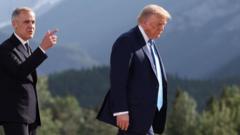**As trade negotiations continue, observers assess the implications of Canada's concessions and the pressure faced by Carney's administration.**
**Canada's Trade Strategy Under Scrutiny as Tariff Threats Loom**

**Canada's Trade Strategy Under Scrutiny as Tariff Threats Loom**
**Amid growing tensions between Canada and the U.S., Prime Minister Mark Carney's negotiation tactics are called into question after Trump's latest tariff threat.**
As Canada grapples with renewed trade tensions with the United States, Prime Minister Mark Carney is confronting scrutiny regarding his approach to negotiations under President Donald Trump. The latest challenge comes in the form of a surprise 35% tariff on Canadian goods that Trump hinted at starting next month, raising concerns about the trajectory of the ongoing talks aimed at securing a better trading framework.
Carney, who campaigned on a robust defense of Canadian interests with a pledge to keep his "elbows up"—a metaphor borrowed from ice hockey to describe a tenacious style—now faces criticism as recent concessions appear to yield minimal results. His administration recently reversed its earlier decision to implement a Digital Services Tax (DST) targeting major tech firms following Trump's threats to halt talks altogether. The White House characterized this retreat as a sign of capitulation, igniting a heated debate among Canadian commentators and political analysts.
Robyn Urback, a commentator, suggested that Carney's aggressive negotiating style was faltering, implying that his previous assertiveness was dwindling. Meanwhile, political science professor Blayne Haggart criticized Carney's strategy as lacking coherence, stating that relinquishing the DST has produced "less than nothing."
Despite these doubts, some maintain faith in Carney's ability to navigate the complex U.S.-Canada relationship, at least for the moment. Former adviser Roland Paris emphasized the significance of the impending final agreement between the nations, acknowledging Trump's tough negotiation tactics. He cautioned, however, that if Carney appears to concede significantly and the resulting agreement is unfavorable, he may incur political consequences domestically.
In a broader context, the Canadian government is committed to defending its workforce amidst Trump's tariff threats, embracing various strategies, including a substantial financial pledge for border security and appointing a "fentanyl czar" to appease the U.S. administration. Nevertheless, when tariffs on steel and aluminum were recently increased, Carney's administration did not respond with countermeasures, further raising eyebrows.
The Canadian government maintains a clear stance on negotiating terms that protect its interests while aiming for a comprehensive deal before the revised deadline of August. Fortunately for the country, the proposed tariffs will not immediately extend to products covered under the US-Mexico-Canada Agreement (USMCA), which includes the majority of bilateral trade.
While the Canadian political landscape remains steadfastly united against Trump's tariff threats, with leaders from both sides of the aisle calling for collective action, experts suggest that Canada may still hold strategic advantages. With Canadian goods being critical to many American manufacturers, the notion that "American consumers will bear the brunt of the tariffs" reinforces this argument.
As the trade discourse unfolds, Carney's government is also exploring avenues to lessen dependency on U.S. markets—evidenced by recent arms deals with the European Union and initiatives to streamline domestic trade. Industry Minister Melanie Joly underscored the unpredictability of the current U.S. administration while reaffirming Canada's commitment to firm negotiations.
In these uncertain times, it remains crucial for observers to gauge Canada's performance by the overarching outcome of the trade negotiations rather than by isolated concessions made along the way.





















